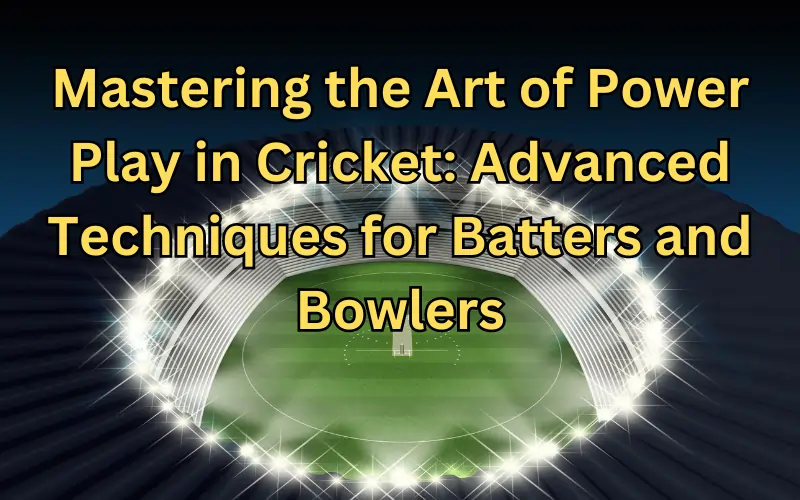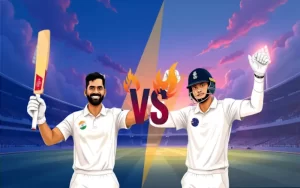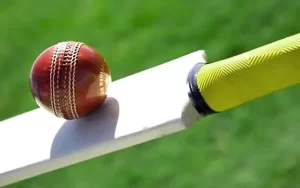In the world of cricket at CBTF Guru, the Power Play in cricket is a critical phase that can significantly influence the outcome of a match. Whether you’re a batter looking to maximize runs or a bowler aiming to restrict the opposition, understanding and mastering the nuances of the Power Play is essential. This article delves into advanced techniques for both batters and bowlers, offering insights that can help you dominate this crucial phase of the game.
What is Power Play?

In limited-overs cricket, the Power Play in cricket refers to a specific period when fielding restrictions are imposed, limiting the number of fielders allowed outside the 30-yard circle. These restrictions create opportunities and challenges for both batters and bowlers:
In One-Day Internationals (ODIs): The Power Play is divided into three phases:
- Overs 1-10: Only two fielders are allowed beyond the 30-yard circle.
- Overs 11-40: Four fielders can be placed outside the circle.
- Overs 41-50: Five fielders can be positioned outside the circle.
In T20 Internationals: The Power Play runs for the first six overs, with only two fielders designated outside the 30-yard circle.
Understanding the dynamics of the Power Play in cricket is essential for capitalizing on its advantages and minimizing its risks. Let’s explore some advanced techniques for batters and bowlers to excel during this phase.
Techniques for Batters
1. Aggressive Shot Selection
During the Power Play in cricket, the fielding restrictions provide an excellent opportunity to score boundaries. As a batter, it’s important to choose proper shots that align with your abilities and the field placements. Here are some advanced shot selections:
- Lofted Shots: With only two fielders outside the circle, lofted shots over the infield can be highly effective. Focus on hitting straight or over mid-off and mid-on, where the fielders are usually positioned within the circle.
- Inside-Out Shots: This technique is particularly useful against spinners. By moving across your stumps, you can create angles to hit over cover or extra cover, taking advantage of the lack of protection in the deep.
- Scoops and Ramps: Modern cricket has seen innovative shots like the scoop or ramp, where batters use the pace of the bowler to guide the ball over the wicketkeeper’s head. These shots are risky but can yield big rewards when executed well.
2. Rotation of Strike
While boundaries are crucial during the Power Play in cricket, consistently rotating the strike is equally important. This keeps the scoreboard ticking and disrupts the bowler’s rhythm. Use the following techniques:
- Soft Hands: Playing the ball with soft hands allows you to place it in the gaps within the infield, enabling quick singles.
- Drop and Run: This involves gently tapping the ball into the off-side or leg-side and immediately setting off for a run. Communication with your partner is key to avoiding run-outs.
3. Targeting Weak Links
Many times, a weak link in a bowling attack is a bowler who isn’t very good or is just having a bad day. Identifying and targeting this bowler during the Power Play in cricket can put pressure on the opposition.
- Analyze Early: Spend the first few deliveries analyzing the bowler’s length, line, and pace. Once you’ve identified any weaknesses, go on the offensive.
- Exploit Field Placements: If the bowler is struggling with line or length, take advantage of the field placements. For instance, if the bowler is consistently short, be ready to pull or cut the ball into the gaps.
SIGN UP AND GET UP TO 100% WELCOME BONUS!
Techniques for Bowlers
1. Variation in Pace
One of the most effective ways to counter aggressive batters during the Power Play in cricket is by varying your pace. By mixing up your deliveries, you can keep the batter guessing and make it difficult for them to time their shots.
- Off-Cutters and Leg-Cutters: These slower deliveries can deceive batters expecting a quicker ball. Use them to force a mistimed shot, particularly when the batter is looking to hit over the top.
- Slower Bouncers: A well-disguised slower bouncer can catch the batter off guard, especially if they are expecting a full delivery. This can result in a top-edge or a mishit.
2. Bowling to a Plan
As a bowler, it’s crucial to have a clear plan for each batter. This involves understanding their strengths and weaknesses and setting the field accordingly.
- Bowling Wide Outside Off: Against aggressive batters, bowling wide outside off-stump with a packed off-side field can frustrate them into playing risky shots.
- Targeting the Stumps: Bowling straight and full, striking the stumps, can be helpful during the Power Play in cricket. This limits the batter’s ability to free their arms and hit through the line.
3. Utilizing Field Placements
Even with the restrictions, intelligent field placements can make a significant difference. As a bowler, work closely with your captain to set fields that complement your bowling strategy.
- In-Out Fields: A combination of in-fielders to stop singles and boundary riders to cut off boundaries can pressure the batter into making mistakes.
- Attacking Fields: If you’re on top, don’t hesitate to set attacking fields, such as a slip or a short cover, even during the Power Play. This can create opportunities for wickets through pressure.
Adapting to Different Conditions
1. Pitch Conditions
The nature of the pitch plays a crucial role in determining the effectiveness of Power Play in cricket strategies. On a flat pitch, batters may find it easier to score boundaries, so bowlers need to focus on variations and tight lines.
- Dry and Slow Pitch: On a slow pitch, spinners can come into play even during the Power Play. Batters should focus on timing rather than power, while bowlers can use flight and turn to deceive batters.
- Green and Seaming Pitch: On a pitch with grass, fast bowlers can exploit seam movement. Batters need to be cautious and look to play late, while bowlers should focus on hitting the right areas to generate movement.
2. Weather Conditions
Weather conditions such as humidity, wind, and overcast skies can also influence Power Play in cricket tactics. Swing bowlers may find more assistance in humid or overcast conditions, while wind direction can affect shot selection for batters.
Psychological Aspects of Power Play
1. Maintaining Composure
The Power Play in cricket is often a high-pressure phase, particularly for bowlers. Maintaining composure and sticking to your plan is crucial.
- For Batters: Avoid getting carried away by the fielding restrictions. While it’s important to be aggressive, calculated risks are more effective than reckless hitting.
- For Bowlers: Don’t get disheartened by boundaries. Focus on your strengths and stick to the game plan. Remember, one good delivery can turn the tide.
2. Reading the Game
Both batters and bowlers should continuously read the game situation and adapt accordingly. If the batting team has a strong start, bowlers might need to pull back and focus on damage control. Conversely, if wickets fall early, batters may need to stabilize the innings rather than go for big shots.
Conclusion
Mastering the art of Power Play in cricket requires a blend of skill, strategy, and adaptability. For batters, it’s about selecting the right shots, rotating the strike, and targeting weak links. For bowlers, variations in pace, strategic field placements, and sticking to a plan are key to success.
By understanding and implementing these advanced techniques on CricHQ, players can make the most of the Power Play, whether they are looking to score big or restrict the opposition. As with any aspect of cricket, practice and experience will refine these skills, ultimately leading to greater success on the field.






